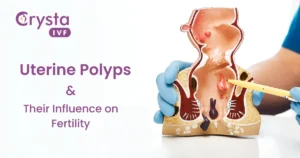An Overview:
A hydrosalpinx is a fluid-filled fallopian tube blockage that can potentially interfere with your ability to conceive. A blocked fallopian tube can result from any damage, most commonly from an untreated infection. The tubes can be drained, repaired, or removed (salpingectomy) as part of the treatment. IVF is frequently chosen by singles and couples who wish to become parents after receiving treatment for Hydrosalpinx.

What is Hydrosalpinx?
It is a condition where one or both fallopian tubes get blocked due to the accumulation of fluids. Every month, as per your menstrual cycle, ovaries produce one egg that travels through your fallopian tubes. Healthy fallopian tubes allow an open pathway for the egg and sperm to merge. Once fertilization occurs, it travels the same way, reaches the uterus, and develops into a fetus.
But when you suffer from Hydrosalpinx, fluid builds up in the pathway. The blocked tube prevents sperm from reaching the egg, and fertilization fails. But let’s say somehow fertilization does take place; the blocked tube can even stop the embryo from traveling and reaching the uterus and prevent it from implanting itself.
As per various studies, 20 to 30% of infertility cases are caused due to issues in fallopian tubes. Out of those cases, Hydrosalpinx constitutes about 10 to 20%.
Must Read: Fallopian Tube Blockage Symptoms, Causes & Treatment
Effects of Hydropalsinx in the body:
The problem with this condition is that Hydrosalpinx symptoms are mostly hidden unless your doctor makes a diagnosis to identify the cause of the failed pregnancy. It can cause the following problems:
- Increases the ectopic (tubal) pregnancy: An ectopic pregnancy could occur from an embryo that implants in your fallopian tubes after being blocked from entering your uterus. Without medical attention, these pregnancies are not viable and may even be fatal.
- Reduces your chance of pregnancy with In Vitro Fertilization (IVF): During IVF treatment, the embryo that’s implanted into your uterine wall can cause complications if you have a hydrosalpinx. According to research, the fluid from a hydrosalpinx may flow backward into your uterus, putting the embryo in an unfavorable environment as it develops.
But there are some physical signs as well, such as:
- You could experience pelvic pain that may worsen during or immediately after your period.
- You may experience vaginal discharge that’s discolored or sticky.
Also Read: What are the chances of getting pregnant with one Fallopian tube
Hydrosalpinx Causes:
The most common reason for Hydrosalpinx is an untreated infection. Infections caused by harmful bacteria can damage the fallopian tubes and cause them to become inflamed. The inflammation mostly happens in the fimbriae, a part of the fallopian tube close to the ovaries. Your fimbriae are finger-like extensions that take the egg from the ovaries and send it to the fallopian tubes.
When the fimbriae are infected, they start a self-haling process where they fuse, sealing the fallopian tubes. The fluid inside the tubes gets trapped, causing them to swell.
Infections that cause hydrosalpinx include:
- Prior STIs, such as gonorrhea and chlamydia, left untreated
- PID, or pelvic inflammatory disease
- Tissue remnants from pelvic surgery, particularly if your fallopian tubes were operated on
- Swelling caused by endometriosis
- Tumors
Diagnosis & Treatment
Hydrosalpinx diagnosis includes:
- Ultrasound: Fallopian tubes are normally invisible during an ultrasound. However, this could be a sign of hydrosalpinx if they enlarge or take on a sausage-like shape due to fluid accumulation. Additional tests are frequently ordered to confirm this condition and gain a thorough understanding of the problem.
- Hysterosalpingogram (HSG): An X-ray dye test called HSG is used to look for fallopian tube blockages. It is the most widely utilized test for hydrosalpinx diagnosis. A dye medium is inserted into your uterus to check and monitor its movement via an X-ray. If the dye leaks into your pelvis, then it means that your tubes are open. But if the dye stays and stops anywhere, your tubes are blocked.
- Laparoscopy: It is a minimally invasive surgery that allows your doctor to see inside your abdominal cavity. Tiny cuts are made into your belly, and a small camera (laparoscope) is inserted inside to look closer at your fallopian tubes. Sometimes, a catheter is inserted into the vagina and cervix to pump dye into the uterus and fallopian tubes to check for blockages. This method is used to confirm the results of an HSG.
Also Read: When to Have IVF Treatment and Why – A Guide
Hydrosalpinx treatment includes:
- Salpingectomy: This process means the removal of one or both fallopian tubes. This procedure is done to lower the risk of ovarian cancer, treat specific gynecological conditions, and prevent ectopic pregnancies.
- Neosalpingostomy, also known as salpingostomy, removes the blockage from your tubes. Salpingostomy procedures are usually performed with a laparoscopy. A tiny incision is made in the fallopian tube to drain it, also removing the sealed-off ends of the tube. Today, salpingostomy is a less common option than IVF because of the increased risk of miscarriage and pregnancy complications.
Hydrosalpinx and IVF do not work well together because hydrosalpinx reduces the likelihood of IVF pregnancy. Combining IVF with hydrosalpinx surgery is the best course of action. The presence of hydrosalpinx lowers the success rate of IVF. For this condition, removal of the fallopian tube, along with any adhesions, scar tissue, and endometrial growth, is the recommended course of treatment. By removing barriers from the fertility treatment process, this all-inclusive approach raises the chances of successful IVF outcomes.
Also Read: IVF Process in 3 Simple Steps: Stimulate, Retrieve, Transfer

Conclusion:
To sum up, hydrosalpinx is a serious problem for fertility. Complications like ectopic pregnancies and lower IVF success rates can result from the condition. Effective treatment depends on a thorough diagnosis with laparoscopy, HSG, and ultrasound. For best results, combining IVF with hydrosalpinx surgery is highly advised. Crysta IVF, the best IVF clinic in Noida, run by experienced doctors and embryologists, is essential in addressing these issues and offering individualized and practical solutions to people and couples hoping to start a family.
Read more blogs:
How To Deal With Unexplained Infertility?
Fertility Tests for Women: Embarking on the Journey to Motherhood with Crysta IVF
Understanding Premenstrual Syndrome (PMS) and its Relationship with Fertility
Asherman Syndrome and its Connection with Fertility
What is the ERA Test? Endometrial Receptivity Array Procedure, Cost in India




